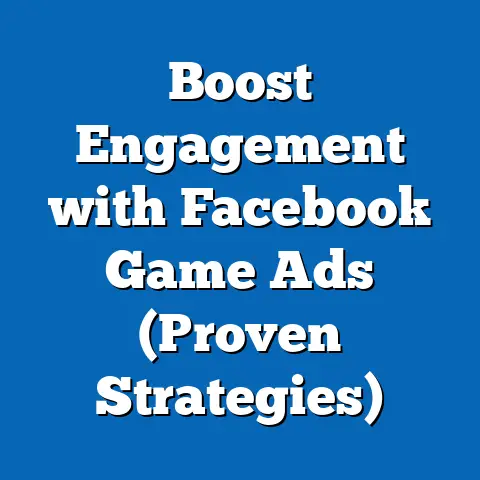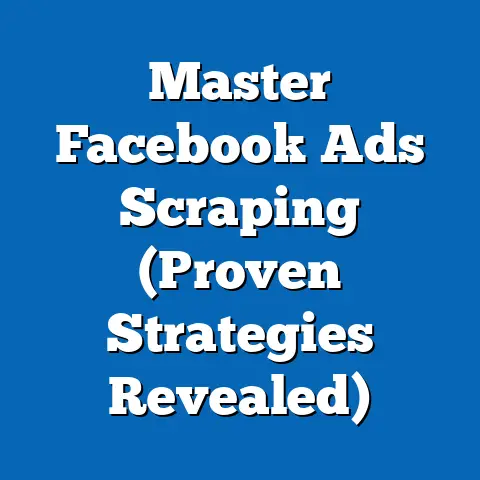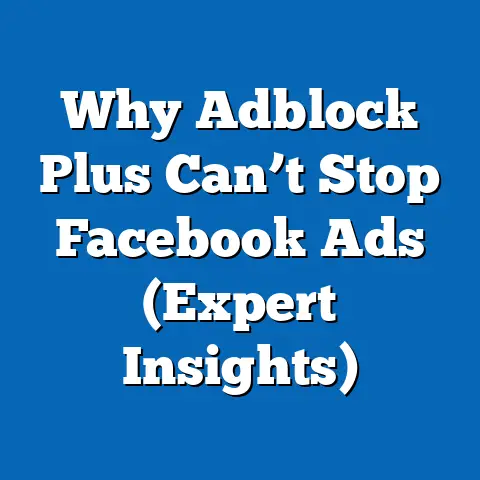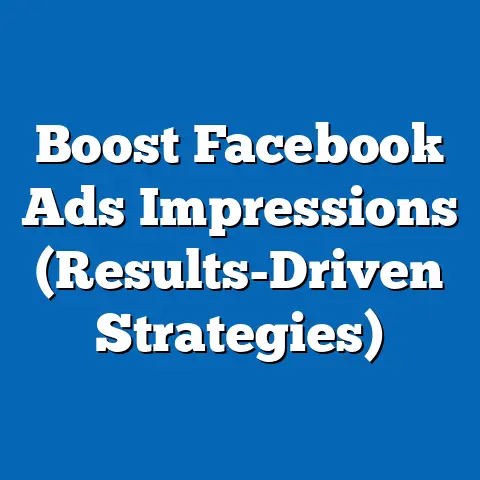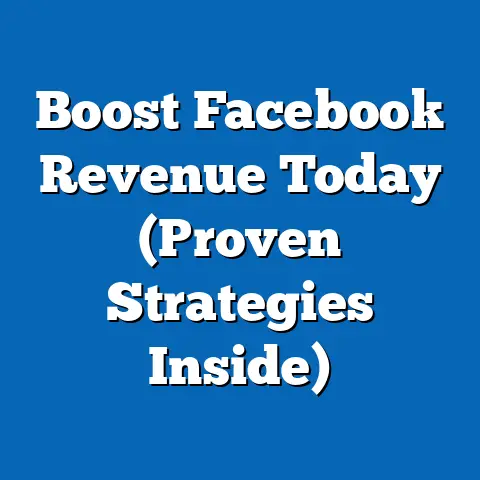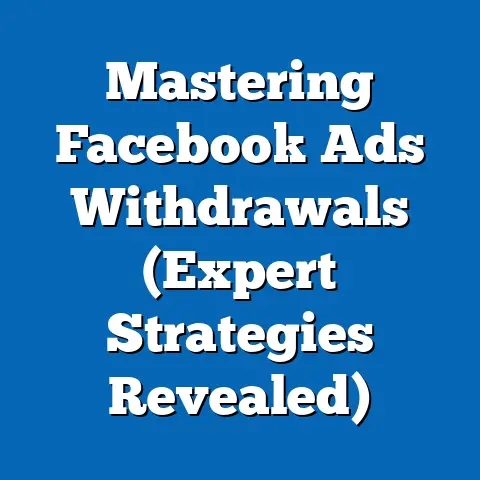Understanding Facebook Ad Feed (Expert Insights)
Understanding Facebook Ad Feed: Expert Insights into Its Versatility
Facebook advertising has become an indispensable tool for businesses aiming to connect with their target audiences. Over the years, the platform has evolved from simple banner ads to a sophisticated ecosystem capable of delivering highly personalized and engaging content. With over 2.91 billion monthly active users, Facebook offers unparalleled reach and targeting capabilities. For instance, a recent study by Statista revealed that 93% of marketers use Facebook for advertising, underscoring its importance in the digital marketing landscape.
I’ve spent years navigating the ever-changing landscape of Facebook Ads, and I can tell you firsthand that understanding the Facebook Ad Feed is crucial for any business looking to make a significant impact. It’s not just about throwing money at ads; it’s about understanding how the feed works, who you’re targeting, and what kind of content resonates with your audience. This article will provide you with expert insights into the Facebook Ad Feed, covering its anatomy, the role of user data, creative best practices, metrics for measuring success, common challenges, and a glimpse into the future.
1. The Anatomy of the Facebook Ad Feed
The Facebook Ad Feed is more than just a stream of content; it’s a complex system designed to deliver relevant ads to users based on their interests, behaviors, and demographics. Understanding its structure is the first step to creating effective ad campaigns.
Ad Placements
Facebook offers various ad placements, each with its unique characteristics and advantages. The most common placements include:
- Facebook Feed: Ads appear directly within the user’s news feed, blending seamlessly with organic content.
- Instagram Feed: Similar to the Facebook Feed, but on Instagram.
- Facebook Marketplace: Ads are displayed within the Marketplace section, ideal for e-commerce businesses.
- Facebook Stories: Short, engaging ads that appear between users’ stories.
- Instagram Stories: Same as Facebook Stories, but on Instagram.
- Facebook Right Column: Ads appear on the right side of the desktop version of Facebook.
- Audience Network: Extends your ads to a network of third-party apps and websites.
Each placement offers different benefits. For example, Facebook and Instagram Feeds are great for brand awareness and engagement, while Marketplace is ideal for driving sales. I’ve found that testing different placements is crucial to identifying which ones perform best for your specific campaign goals.
Ad Formats
Facebook supports a variety of ad formats, allowing you to present your message in the most engaging way possible. Here are some of the most popular formats:
- Single Image Ads: A simple yet effective format featuring a single image and accompanying text.
- Single Video Ads: Video ads are highly engaging and can convey a lot of information in a short amount of time.
- Carousel Ads: Showcase multiple images or videos in a swipeable format, perfect for highlighting different products or features.
- Slideshow Ads: Create a video-like experience using a series of still images.
- Collection Ads: Designed for e-commerce, these ads feature a hero image or video followed by a selection of products.
- Instant Experience Ads: Full-screen, mobile-optimized ads that load instantly and provide an immersive experience.
In my experience, video ads tend to perform exceptionally well, especially when they’re optimized for mobile viewing. However, the best format depends on your specific goals and the type of content you’re promoting.
Algorithmic Personalization
Facebook’s algorithm plays a crucial role in determining which ads appear to each user. This algorithm takes into account various factors, including:
- User Interests: Based on the pages they like, the groups they join, and the content they interact with.
- Demographics: Age, gender, location, education, and other demographic information.
- Online Behavior: Websites they visit, apps they use, and purchases they make.
- Ad Relevance: How relevant the ad is to the user based on their past interactions.
The algorithm aims to show users ads that are most likely to be of interest to them, creating a more positive experience and increasing the likelihood of engagement. As an advertiser, understanding how the algorithm works is essential for optimizing your campaigns and ensuring your ads reach the right people.
Takeaway: The Facebook Ad Feed is a complex system with various ad placements, formats, and algorithmic personalization. Understanding these components is crucial for creating effective ad campaigns.
2. The Role of User Data and Targeting
Facebook’s powerful targeting capabilities are one of its biggest strengths. By leveraging user data, advertisers can create highly targeted campaigns that reach the most relevant audience.
Types of Data Collected
Facebook collects a vast amount of data on its users, including:
- Demographic Data: Age, gender, location, education, relationship status, and more.
- Interest Data: Interests based on the pages they like, the groups they join, and the content they interact with.
- Behavioral Data: Online behavior, such as websites they visit, apps they use, and purchases they make.
- Custom Audiences: Data you upload yourself, such as customer lists or website visitors.
- Lookalike Audiences: Audiences that are similar to your existing customers.
This data allows advertisers to create highly targeted campaigns that reach the most relevant audience. I’ve found that using a combination of different targeting options can significantly improve campaign performance.
Effective Audience Segmentation
Audience segmentation involves dividing your target audience into smaller groups based on specific characteristics. This allows you to tailor your ads to each segment, increasing their relevance and effectiveness. Common segmentation criteria include:
- Demographics: Target users based on age, gender, location, and other demographic factors.
- Interests: Target users based on their interests and hobbies.
- Behaviors: Target users based on their online behavior, such as purchase history or website visits.
- Custom Audiences: Target existing customers or website visitors.
- Lookalike Audiences: Target users who are similar to your existing customers.
For example, if you’re selling running shoes, you might segment your audience based on their interest in running, their purchase history of athletic apparel, or their visits to running-related websites. By tailoring your ads to each segment, you can increase their relevance and improve campaign performance.
Maintaining User Privacy
While Facebook offers powerful targeting capabilities, it’s essential to respect user privacy and comply with advertising policies. This includes:
- Transparency: Be transparent about how you’re using user data.
- Consent: Obtain consent before collecting or using user data.
- Compliance: Comply with all applicable privacy laws and regulations, such as GDPR and CCPA.
- Respect: Respect user privacy and avoid using sensitive data in your targeting.
Facebook has become increasingly strict about privacy, and violating these policies can result in your ads being disapproved or your account being suspended. Always prioritize user privacy and ensure your campaigns are compliant with all applicable regulations.
Takeaway: User data and targeting are crucial for creating effective Facebook ad campaigns. However, it’s essential to respect user privacy and comply with advertising policies.
3. Creative Best Practices for Facebook Ads
Creative content is the heart of any successful Facebook ad campaign. It’s what grabs the user’s attention and motivates them to take action. Here are some best practices for creating effective Facebook ads:
Visual Storytelling
Visual storytelling involves using images and videos to tell a story that resonates with your audience. This can be a powerful way to connect with users on an emotional level and build brand loyalty. Some tips for visual storytelling include:
- Use High-Quality Images and Videos: Ensure your visuals are clear, well-lit, and visually appealing.
- Focus on Emotion: Create visuals that evoke emotions, such as joy, excitement, or inspiration.
- Showcase Your Brand: Incorporate your brand’s colors, fonts, and logo into your visuals.
- Tell a Story: Create visuals that tell a story that resonates with your audience.
For example, if you’re selling travel packages, you might create a video that shows stunning destinations and happy travelers enjoying their vacations. By telling a story that resonates with your audience, you can increase their engagement and drive sales.
The Role of Copywriting
Copywriting is the art of writing persuasive text that motivates users to take action. Your ad copy should be clear, concise, and compelling. Some tips for effective copywriting include:
- Highlight Benefits: Focus on the benefits of your product or service, rather than just the features.
- Use Strong Calls to Action: Tell users exactly what you want them to do, such as “Shop Now,” “Learn More,” or “Sign Up.”
- Keep It Concise: Get to the point quickly and avoid using jargon or technical terms.
- Use Emotion: Appeal to the user’s emotions and create a sense of urgency.
For example, instead of saying “Our product has advanced features,” you might say “Our product will save you time and money.” By highlighting the benefits and using strong calls to action, you can increase the likelihood of users taking action.
A/B Testing
A/B testing involves creating multiple versions of your ad and testing them against each other to see which one performs best. This allows you to optimize your ads and improve their effectiveness. Some tips for A/B testing include:
- Test One Variable at a Time: Test different headlines, images, calls to action, or targeting options.
- Use a Large Sample Size: Ensure you have enough data to draw meaningful conclusions.
- Track Your Results: Monitor your key performance indicators (KPIs) to see which version performs best.
- Iterate and Improve: Continuously test and optimize your ads based on your results.
For example, you might test two different headlines to see which one generates more clicks. By continuously testing and optimizing your ads, you can significantly improve their performance over time.
Latest Trends in Ad Creativity
The world of ad creativity is constantly evolving, and it’s essential to stay up-to-date with the latest trends. Some of the latest trends in ad creativity include:
- Augmented Reality (AR): AR ads allow users to interact with your product or service in a virtual environment.
- Interactive Content: Interactive ads, such as polls, quizzes, and games, can increase user engagement.
- Personalized Ads: Personalized ads are tailored to the individual user based on their interests and behaviors.
- Short-Form Video: Short, engaging videos are highly effective at capturing attention and conveying information.
I’ve seen firsthand how these trends can significantly improve ad performance. For example, AR ads can allow users to try on virtual clothes or see how furniture would look in their home, increasing their likelihood of making a purchase.
Takeaway: Creative content is the heart of any successful Facebook ad campaign. Focus on visual storytelling, effective copywriting, A/B testing, and staying up-to-date with the latest trends.
4. Measuring Success: Metrics and KPIs
Measuring the success of your Facebook ad campaigns is crucial for understanding what’s working and what’s not. Key Performance Indicators (KPIs) provide valuable insights into your campaign performance and help you make data-driven decisions.
Key Performance Indicators (KPIs)
Some of the most important KPIs to track include:
- Click-Through Rate (CTR): The percentage of users who click on your ad after seeing it. A high CTR indicates that your ad is relevant and engaging.
- Conversion Rate: The percentage of users who complete a desired action, such as making a purchase or signing up for a newsletter. A high conversion rate indicates that your ad is effectively driving conversions.
- Cost Per Click (CPC): The amount you pay each time someone clicks on your ad. A low CPC indicates that your ad is efficiently driving traffic.
- Cost Per Conversion (CPA): The amount you pay for each conversion. A low CPA indicates that your ad is efficiently driving conversions.
- Return on Ad Spend (ROAS): The amount of revenue you generate for every dollar you spend on advertising. A high ROAS indicates that your ad is generating a positive return on investment.
- Reach: The number of unique users who saw your ad.
- Impressions: The number of times your ad was displayed.
- Frequency: The average number of times each user saw your ad.
I’ve found that tracking these KPIs on a regular basis is essential for optimizing your campaigns and ensuring you’re getting the best possible return on your investment.
Interpreting Metrics
Interpreting your KPIs correctly is crucial for making informed decisions. Here are some tips for interpreting common metrics:
- High CTR, Low Conversion Rate: This indicates that your ad is engaging but your landing page or offer is not compelling enough.
- Low CTR, High Conversion Rate: This indicates that your ad is not reaching the right audience, but those who do click are highly interested.
- High CPC, Low CPA: This indicates that your ad is driving traffic but not generating conversions efficiently.
- Low CPC, High CPA: This indicates that your ad is generating conversions efficiently but not driving enough traffic.
By analyzing your KPIs and understanding their implications, you can identify areas for improvement and optimize your campaigns accordingly.
Data-Driven Decisions
Making data-driven decisions is essential for maximizing the effectiveness of your Facebook ad campaigns. This involves:
- Tracking Your KPIs: Monitor your KPIs on a regular basis.
- Analyzing Your Results: Identify trends and patterns in your data.
- Testing Different Strategies: Experiment with different ad creatives, targeting options, and bidding strategies.
- Optimizing Your Campaigns: Continuously optimize your campaigns based on your results.
For example, if you notice that your CTR is low, you might test different headlines or images to see which ones generate more clicks. By continuously testing and optimizing your campaigns based on data, you can significantly improve their performance over time.
Takeaway: Measuring success is crucial for optimizing your Facebook ad campaigns. Track your KPIs, interpret your metrics correctly, and make data-driven decisions to maximize your return on investment.
5. Common Challenges and Solutions
Even with the best strategies and creative content, advertisers often face challenges when using the Facebook Ad Feed. Understanding these challenges and having solutions in place is crucial for maintaining effective campaigns.
Ad Fatigue
Ad fatigue occurs when users become tired of seeing the same ad repeatedly. This can lead to a decrease in engagement and a decline in campaign performance. Some strategies for combating ad fatigue include:
- Rotating Your Ads: Regularly update your ad creatives and copy to keep them fresh.
- Expanding Your Targeting: Reach new audiences by expanding your targeting options.
- Using Different Ad Formats: Experiment with different ad formats to keep your ads engaging.
- Frequency Capping: Limit the number of times each user sees your ad.
I’ve found that rotating my ads every few weeks can significantly reduce ad fatigue and improve campaign performance.
Audience Saturation
Audience saturation occurs when you’ve reached the majority of your target audience and there are fewer new users to reach. This can lead to a decrease in reach and an increase in costs. Some strategies for combating audience saturation include:
- Expanding Your Targeting: Reach new audiences by expanding your targeting options.
- Creating Lookalike Audiences: Target users who are similar to your existing customers.
- Using Different Ad Placements: Experiment with different ad placements to reach new audiences.
- Refining Your Audience: Narrow down your audience to reach the most engaged users.
For example, creating lookalike audiences can allow you to reach new users who are likely to be interested in your product or service.
Compliance with Advertising Policies
Facebook has strict advertising policies that advertisers must comply with. Violating these policies can result in your ads being disapproved or your account being suspended. Some common violations include:
- Misleading or Deceptive Content: Avoid making false or misleading claims about your product or service.
- Prohibited Content: Do not promote illegal or harmful products or services.
- Personal Attributes: Do not target users based on sensitive personal attributes, such as race, religion, or sexual orientation.
- Copyright Infringement: Do not use copyrighted material without permission.
Always review Facebook’s advertising policies carefully and ensure your ads are compliant. If you’re unsure about a particular policy, consult with a legal professional.
Overcoming Hurdles
Overcoming these hurdles requires a proactive approach and a willingness to adapt your strategies. Some general tips for overcoming challenges include:
- Stay Informed: Keep up-to-date with the latest trends and best practices in Facebook advertising.
- Test and Optimize: Continuously test and optimize your campaigns based on data.
- Seek Expert Advice: Consult with a Facebook advertising expert for guidance and support.
- Be Patient: Facebook advertising takes time and effort. Don’t get discouraged if you don’t see results immediately.
Takeaway: Advertisers often face challenges when using the Facebook Ad Feed. Understanding these challenges and having solutions in place is crucial for maintaining effective campaigns.
6. The Future of Facebook Ad Feed
The Facebook Ad Feed is constantly evolving, and it’s essential to stay informed about emerging trends and future developments. Here’s a glimpse into what the future might hold:
AI-Driven Ad Personalization
Artificial intelligence (AI) is playing an increasingly important role in Facebook advertising. AI-driven ad personalization can help advertisers create more relevant and engaging ads that are tailored to the individual user. This can lead to improved campaign performance and a better user experience.
I believe that AI will continue to play a significant role in the future of Facebook advertising, enabling advertisers to create more personalized and effective campaigns.
Integration of E-Commerce Functionalities
Facebook is increasingly integrating e-commerce functionalities into its platform, making it easier for users to discover and purchase products directly on Facebook. This includes features such as:
- Facebook Shops: Allows businesses to create a virtual storefront on Facebook.
- Product Tags: Allows businesses to tag products in their posts and ads.
- Checkout: Allows users to purchase products directly on Facebook without leaving the platform.
These features make it easier for businesses to drive sales and for users to discover and purchase products. I expect that Facebook will continue to expand its e-commerce functionalities in the future.
Impact of Evolving Privacy Regulations
Evolving privacy regulations, such as GDPR and CCPA, are having a significant impact on Facebook advertising. These regulations give users more control over their data and require advertisers to be more transparent about how they’re using user data.
Advertisers need to comply with these regulations and prioritize user privacy. This includes:
- Obtaining Consent: Obtain consent before collecting or using user data.
- Transparency: Be transparent about how you’re using user data.
- Compliance: Comply with all applicable privacy laws and regulations.
I believe that privacy will continue to be a major focus in the future of Facebook advertising, and advertisers need to adapt to these changes.
Takeaway: The Facebook Ad Feed is constantly evolving, and it’s essential to stay informed about emerging trends and future developments.
Conclusion
The Facebook Ad Feed is a versatile and powerful tool for marketers. By understanding its anatomy, leveraging user data, creating compelling content, measuring success, and staying informed about emerging trends, you can maximize the effectiveness of your Facebook ad campaigns.
It’s crucial to remember that the digital landscape is ever-changing. Staying informed, adapting to new trends, and continuously optimizing your strategies will be key to your success. Keep testing, keep learning, and keep pushing the boundaries of what’s possible with Facebook advertising. Good luck!

